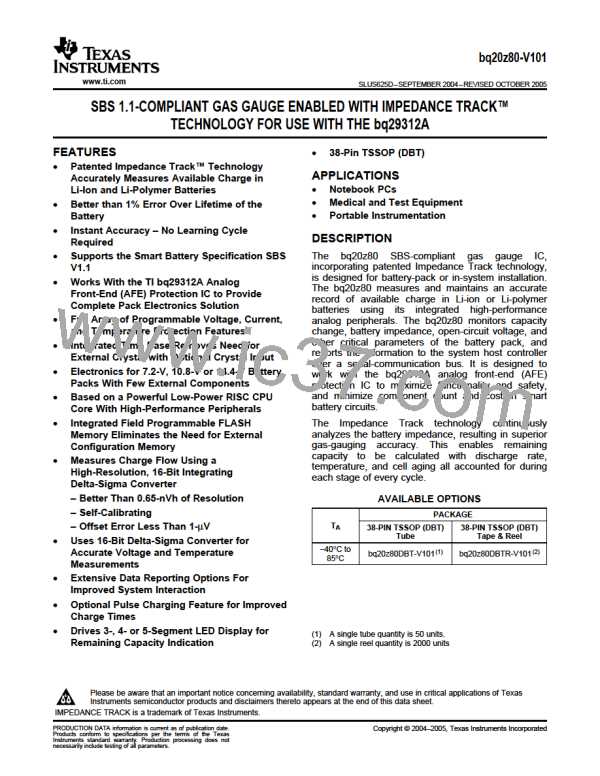bq20z80-V101
www.ti.com
SLUS625D–SEPTEMBER 2004–REVISED OCTOBER 2005
For the bq20z80 to fully recover from a pack undervoltage condition, SBS.Voltage( ) should be ≥ DF:PUV
Recovery threshold. When this occurs, the discharge FET is allowed to be turned on only if other safety and
configuration states permit. On recovery from a pack undervoltage condition, SBS.BatteryStatus( ) [TDA] is reset,
SBS.ChargingCurrent( ) and SBS.ChargingVoltage( ) are set to the appropriate value per the charging algorithm
and SBS.OperationStatus( ) [XDSG] and SBS.SafetyStatus( ) [PUV] are reset.
However, when SBS.SafetyStatus( ) [PUV] is set, the discharge FET is turned on again, as long as
SBS.Current( ) is reported to be ≥ DF:Chg Current Threshold. No other flags change state until full recovery is
reached. This prevents overheating the discharge-FET body diode during charging from an undervoltage
condition.
SIZE
(BYTES)
DEFAULT
VALUE
NAME
DESCRIPTION
FORMAT
VALID RANGE
UNITS
PUV Threshold
PUV Recovery
PUV TIme
0 to 16000
0 to 16000
0 to 60
2
2
1
11000
12000
2
mV
s
1st Level Safety / Voltage (0)
Integer
Charge and Discharge Overcurrent
The bq20z80 has two independent tiers (levels) of overcurrent protection for discharge and charge. These two
tiers require the SBS.Current( ) to be ≥ a programmed threshold in either charge or discharge current for a
period ≥ a programmable time. If the programmable time for any of the current-protection levels is set to 0, that
specific feature is disabled.
The bq29312A provides a third level of discharge overcurrent (overload) protection that reacts according to the
bq29312A internal settings. The bq29312A discharge overcurrent is configured by the bq20z80, where DF:AFE
OC Dsg (see bq29312A OLV register) and DF:AFE OC Dsg Time (see bq29312A OLT register) are used to
provide the current threshold and delay timing. See the 'Overload Detection' section of the bq29312A data sheet
for more details and the appropriate values to use.
For the first two tiers of overcurrent protection, during the period between when excessive current is detected
and the expiration of the timer, the respective SBS.SafetyAlert( ) bit is set. If the timer expires, or SBS.Current( )
returns within normal operating parameters, the SBS.SafetyAlert( ) bit is cleared.
SBS.SAFETYALERT( ),
SBS.SAFETYSTATUS( )
AND DF:Nonremovable Cfg
DF CLEAR
THRESHOLD
DF THRESHOLD
DF TIME
FET
Tier-1
Charge
OC (1st Tier) Chg
OC (2nd Tier) Chg
OC (1st Tier) Dsg
OC (2nd Tier) Dsg
AFE OC Dsg
OC (1st Tier) Chg Time
OC (2nd Tier) Chg Time
OC (1st Tier) Dsg Time
OC (2nd Tier) Dsg Time
AFE OC Dsg Time
CHG
CHG
DSG
DSG
OCC
OCC2
OCD
OC Chg Recovery
Tier-2
Charge
Tier-1
Discharge
OC Dsg Recovery
Tier-2
Discharge
OCD2
AOCD(1)
Tier-3
Discharge
CHG,
DSG
AFE OC DsgRecovery
(1) No SBS.SafetyAlert( ) flag
If the timer of any tier expires during charging, the charge FET is turned off and the ZVCHG FET is turned off if
the DF:Operation Cfg A [ZVCHG1, ZVCHG0] are set appropriately. When this occurs, the internal
AFE_Current_Fault timer is started from 0, SBS.ChargingCurrent( ) and SBS.ChargingVoltage( ) are set to 0,
SBS.BatteryStatus( ) [TCA] is set, and the appropriate tier flag is set in SBS.SafetyStatus( ).
However, when the bq20z80 has either of SBS.SafetyStatus( ) [OCC, OCC2] set, the charge FET is turned on
again, as long as SBS.Current( ) is reported to be ≤ (-) DF:Dsg Current Threshold. No other flags change state
until full recovery is reached. This prevents overheating the charge-FET body diode during discharge. This action
is not affected by the state of DF:Operation Cfg B [NR].
14

 TI [ TEXAS INSTRUMENTS ]
TI [ TEXAS INSTRUMENTS ]